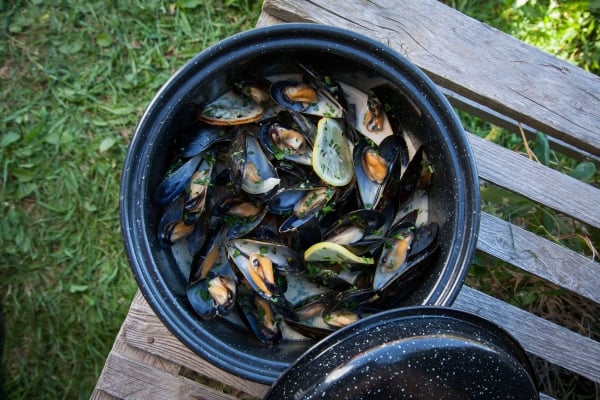Mussels Preparation
Published July 30, 2021 | Tourism PEI
Categories:
Culinary
Mussels, cultured in the cool water surrounding PEI, are rapidly becoming one of North America's most popular seafoods. Although wild mussels, which grow abundantly along shorelines, have long been regarded as trash seafood, people are now becoming aware that cultured mussels are very different. Cultured mussels are grown in mesh stockings that are suspended from longlines (ropes) in the water. Because they never touch the ocean bottom and the ideal conditions promote rapid growth, cultured mussels taste sweeter, are more tender, are plumper, are free of grit and have a higher meat yield than their wild counterpart. As well as being tasty, mussels are nutritious. They are particularly rich in protein and minerals while being low in fat and cholesterol. 3.5 oz (100 g) of mussel meats contain 95 calories, 14.4 g protein, 2.2 g fat, 88 mg. calcium, 3.4 mg. iron and 289 mg sodium.
How to Buy
Mussels are very easy to identify. They are a bi-valve shellfish that measures from two to three inches in length. The shell is primarily a blackish colour with bluish highlights and has an elongated triangular shape. Mussels are traditionally marketed fresh in the shell. The shells are usually closed tightly but they may open slightly when left undisturbed. When purchasing mussels check any open shells by tapping them. If the shells do not close when tapped, they should be discarded. It is relatively easy to distinguish between wild and cultured mussels. Wild mussels, which are a dull bluish colour with white erosion marks, usually have seaweeds or barnacles attached. In contrast, cultured mussels have shiny bluish-black shells, free of barnacles and seaweed.
How to Store
Fresh mussels may be stored in the shell in the coolest part of your refrigerator for five to eight days. To keep them moist, cover with a damp cloth or wet newspaper. They should not be stored in an air-tight container or in water. The less mussels are disturbed, the longer they will remain alive; therefore, the time to clean them is just before cooking. Cooked mussels may be frozen by placing the shucked meats in plastic containers and covering them with a brine solution of 1 teaspoon (5 ml) salt to 1 cup (250 ml) of water. Allow 1/2 inch (1 cm) head space for expansion during freezing. Mussels frozen in this state will store for 3-4 months. If mussels are to be frozen in the shell, they should first be blanched in boiling water for 20 seconds, then drained and packed in heavy plastic bags or plastic containers. Storage time for mussels frozen in the shell is approximately 2 months.
How to Prepare
To prepare mussels for cooking, rinse the shells under cool running water. Remove the byssus threads (a bundle of brown fibres found between the two shells of the mussel) by cutting them with scissors or pulling them out with a quick tug. Mussels are traditionally prepared by steaming over medium heat for 5-7 minutes or until the shells open. Because mussels contain liquid, which comes out during the steaming process, it is not necessary to add any liquid when steaming fresh mussels. If the mussels are several days old, it may be necessary to add about 1/2 inch (1 cm) of liquid to the bottom of the pot. Vegetables such as carrots, celery or onion can also be added for extra flavour. When steaming mussels, cook them only until the shells open wide and the meats become loose from the shell. To continue steaming will overcook the mussels, causing them to be tough and dry. Do not be concerned by the different colours of the mussel meats. The pale white meat indicates a male mussel while the females are a yellowish rust colour. Mussels can easily be prepared in the microwave. Just place the mussels on a shallow pan, add 1/4 cut (50 ml) hot water and cook at a high temperature for 4-5 minutes.
How to Serve
Once the mussels have been steamed open to reveal the meats, they are ready to eat as is, or the meats can be removed and prepared in a variety of dishes. Remember that mussels can be substituted in any recipe calling for clams or oysters. The mussel juice is delicious to drink hot and is especially good if mixed with some melted butter. It can also be chilled and mixed with tomato juice. When serving mussels as an appetizer, allow 10-12 mussels per person (approximately 1/2 pound or 225 g). If the mussels are to be served as a main course, allow 20-25 mussels per person (1 pound or 454 g). For one cup of cooked shucked mussel meats allow 20-25 mussels.



